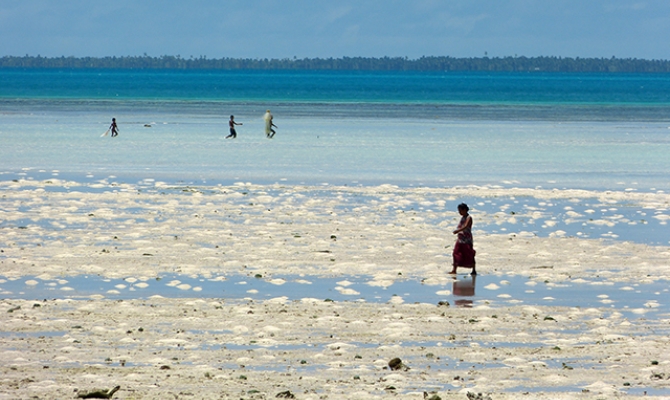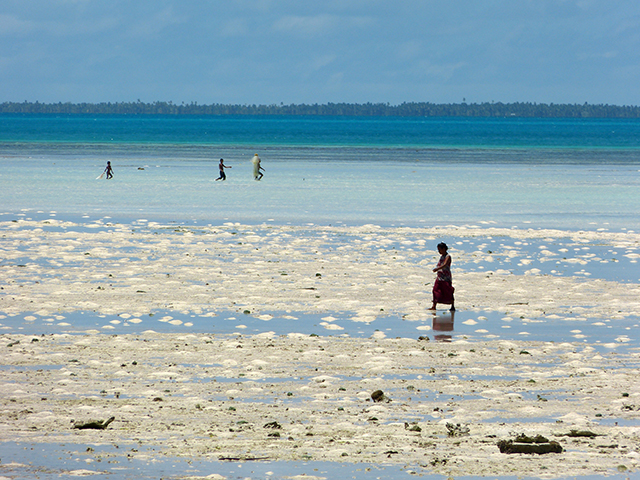
Climate Change Resilience
The Government of Kiribati will launch the Kiribati Joint Implementation Plan for Climate Change and Disaster Risk Management (KJIP) on 29th August 2014 in Tarawa.
The development of the KJIP was initiated and coordinated by the Office of teBeretitenti and driven by the Kiribati National Expert Group (KNEG) through a comprehensive and participatory process, involving all government agencies, non-governmental organisations, the private sector and faith-based organisations as well as community consultation.

The KJIP is designed to mobilise tangible, on-the-ground actions for resilient development within the context of two existing national policy frameworks – the National Disaster Risk Management Plan (NDRMP) and the National Framework for Climate Change and Climate Change Adaptation (NFCCCCA). The KJIP is also aligned with the development goals of the Kiribati Development Plan 2012 - 2015.
Kiribati has been very active in responding to both climate change and disaster impacts at all levels.The added value this KJIP brings is: 1. to ensure that climate variability, climate change and disaster risks (related to meteorological, geological or environmentalrisks) are incorporated in all development planning processes; and 2. to identifytangible on-the-ground actions for all sectors to enable coordination and reduce risks.
The KJIP's vision is: I-Kiribati unique culture, heritage and identity are upheld and safeguarded through enhanced resilience and sustainable development,and the goal is: To increase resilience through sustainable climate change adaptation and disaster risk reduction using a whole of country approach.
The KJIP will be implemented through 12 strategies towards clearly defined results. Performance indicators and prioritised actions are outlined in the Action Matrix to ensure the vision and goal are achieved. It is estimated that approximately AUD104 million is required to implement the KJIP over the next 9 years. This KJIP is expected to eliminate the ad hoc and piece meal approach to development that has sometimes been taken in the past. The approach is carefully designed to promote timely and coherent adaptation, risk reduction and response activities on the ground.
The KJIP development was supported by the Secretariat of the Pacific Regional Environment Programme (SPREP), the Secretariat of the Pacific Community (SPC), the SPC/DeutscheGesellschaftfür Internationale Zusammenarbeit (GIZ) Coping with Climate Change in the Pacific Island Region (CCCPIR) program on behalf of the Federal German Ministry for Economic Cooperation and Development (BMZ), the United Nations Development Programme (UNDP) and the United Nations Children'sFund (UNICEF). The KNEG received additional technical assistance from Australia's Aid Program (AusAid), the European Union (EU) Global Climate Change Alliance (GCCA), the EU African, Caribbean and Pacific Natural Disaster Facility and the United States Agency for International Development (USAID).
The development of the KJIP was initiated and coordinated by the Office of teBeretitenti and driven by the Kiribati National Expert Group (KNEG) through a comprehensive and participatory process, involving all government agencies, non-governmental organisations, the private sector and faith-based organisations as well as community consultation.

Above: Abaiang, Kiribati by C.Iacovino/SPREP
The KJIP is designed to mobilise tangible, on-the-ground actions for resilient development within the context of two existing national policy frameworks – the National Disaster Risk Management Plan (NDRMP) and the National Framework for Climate Change and Climate Change Adaptation (NFCCCCA). The KJIP is also aligned with the development goals of the Kiribati Development Plan 2012 - 2015.
Kiribati has been very active in responding to both climate change and disaster impacts at all levels.The added value this KJIP brings is: 1. to ensure that climate variability, climate change and disaster risks (related to meteorological, geological or environmentalrisks) are incorporated in all development planning processes; and 2. to identifytangible on-the-ground actions for all sectors to enable coordination and reduce risks.
The KJIP's vision is: I-Kiribati unique culture, heritage and identity are upheld and safeguarded through enhanced resilience and sustainable development,and the goal is: To increase resilience through sustainable climate change adaptation and disaster risk reduction using a whole of country approach.
The KJIP will be implemented through 12 strategies towards clearly defined results. Performance indicators and prioritised actions are outlined in the Action Matrix to ensure the vision and goal are achieved. It is estimated that approximately AUD104 million is required to implement the KJIP over the next 9 years. This KJIP is expected to eliminate the ad hoc and piece meal approach to development that has sometimes been taken in the past. The approach is carefully designed to promote timely and coherent adaptation, risk reduction and response activities on the ground.
The KJIP development was supported by the Secretariat of the Pacific Regional Environment Programme (SPREP), the Secretariat of the Pacific Community (SPC), the SPC/DeutscheGesellschaftfür Internationale Zusammenarbeit (GIZ) Coping with Climate Change in the Pacific Island Region (CCCPIR) program on behalf of the Federal German Ministry for Economic Cooperation and Development (BMZ), the United Nations Development Programme (UNDP) and the United Nations Children'sFund (UNICEF). The KNEG received additional technical assistance from Australia's Aid Program (AusAid), the European Union (EU) Global Climate Change Alliance (GCCA), the EU African, Caribbean and Pacific Natural Disaster Facility and the United States Agency for International Development (USAID).